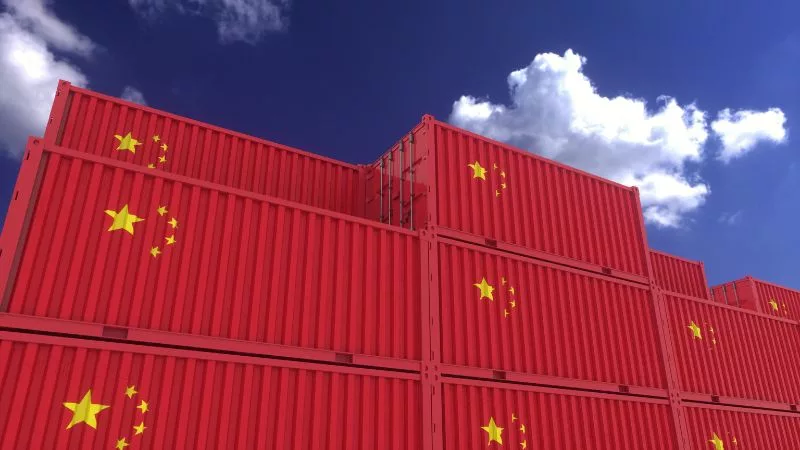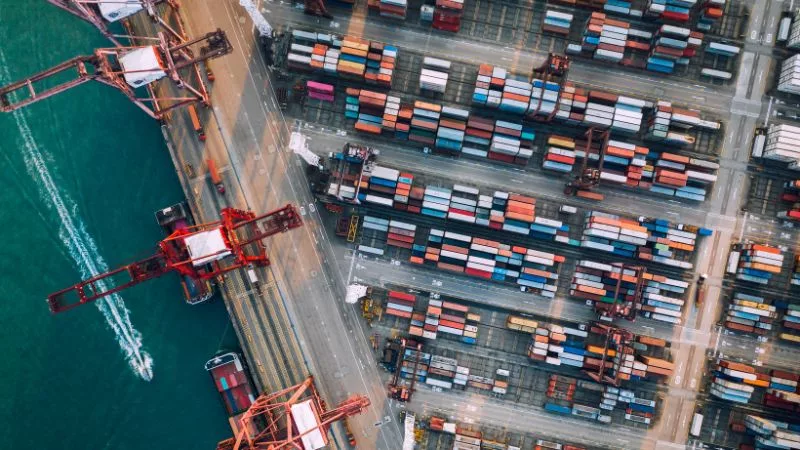Overview of Shipping from China to Zimbabwe
When shipping from China to Zimbabwe, you’ll find that a robust logistics plan and proficient freight forwarders are essential for the seamless transportation of goods.
Importance of Efficient Logistics
Efficient logistics cater to your needs for timely and cost-effective shipping solutions. Each shipping method, whether it’s sea freight or air freight, has its unique advantages. Sea freight can be more cost-effective for larger shipments, while air freight promises faster delivery, about 4-5 business days.
Selecting A Freight Forwarder
The comprehensive freight forwarding is critical for shipping goods from China to Zimbabwe. So, choose an experienced logistics partner like Luckystar.
– Extensive international shipping experience specifically with the China to Zimbabwe route (Luckystar has 20+ years of expertise)
– Comprehensive tracking and express delivery service options
– Strong networks and relationships at ports to enable smooth customs transitions
Additionally, Luckystar is a member of the Federal Maritime Commission (FMC), which can ensure superior, cost-effective service. Luckystar emphasizes dependable delivery timings across a wide coverage area. Their efficient systems and team enable the quickest transportation modes for global shipping.

Types of Shipping Services
When you’re looking to import goods from China to Zimbabwe, you can opt for sea freight for bulk shipments, air freight for quicker deliveries, door-to-door shipping, or road and rail freight for assorted choices.
Sea Freight
Sea freight is a cost-effective option for non-urgent, large-volume shipments from China to Zimbabwe. Transit times range 35-45 days on average. Sea freight utilizes 20ft or 40ft shipping containers suited for heavy, bulky goods.
Full Container Load (FCL) reserves an entire container for your shipment. FCL works well for oversized/heavy cargo and allows control of departure/arrival.
- Suitable for large or heavy shipments
- Gives you control over the container’s departure and arrival times
Less than Container Load (LCL) allows you to ship partial container loads without paying for the whole container. LCL bases cost on cargo volume/weight.
- Ideal for smaller shipments
- Cost is based on the cubic meter/weight of goods
Typical sea freight rates from China to Zimbabwe:
– 20ft container: $3,000-4,500
– 40ft container: $5,000-6,000
Average sea transit times from major China ports to Zimbabwe ports:
| From | To | Transit time |
|---|---|---|
| Guangzhou | victoria falls and hwange | 30 to 45 days |
| Chongqing | victoria falls and hwange | 40 to 45 days |
| Fuzhou | victoria falls and hwange | 36 to 45 days |
| Huangpu | victoria falls and hwange | 35 to 45 days |
| Nansha | victoria falls and hwange | 35 to 45 days |
| Shanghai | victoria falls and hwange | 30 to 45 days |
| Guangzhou | victoria falls and hwange | 35 to 45 days |
| Shenzhen | victoria falls and hwange | 30 to 45 days |
| Xiamen | victoria falls and hwange | 35 to 45days |
Major seaports in Zimbabwe handling China cargo:
– Victoria Falls
– Mutare
– Hwange
– Bulawayo
– Beira
– Harare
Air Freight
Air freight is the fastest method for shipping goods from China to Zimbabwe, with transit times of approximately 4-5 days on average. There are three main international airports in Zimbabwe that handle cargo from China:
- Robert Gabriel Mugabe International Airport
- Joshua Mqabuko Nkomo International Airport
- Victoria Falls International Airport.
The key airlines operating direct passenger flights between China and Zimbabwe are Ethiopian Airlines, which offers flights from Hong Kong to Zimbabwe with total travel times of around 19+ hours including layovers. For air cargo shipments, goods are often routed through connection hubs in Hong Kong, Dubai, Nairobi, Johannesburg or Addis Ababa before final delivery to one of Zimbabwe’s international airports.
Some goods are prohibited or restricted for air freight transport, including narcotics, explosives, biohazards, chemicals, corrosive materials, counterfeit items, ivory, batteries, flammables, firearms, pornography, knives, tobacco, gambling devices and other hazardous materials. Shippers must comply with regulations regarding these prohibited items when arranging international air cargo shipments from China to Zimbabwe.
Door to Door Shipping
With door-to-door shipping, your cargo is picked up from the origin location in China and delivered to the specified destination in Zimbabwe, minimizing handling and simplifying logistics for you. This service includes several steps:
- Pickup: Your cargo is collected at a location of your choice.
- Handling & Clearance: Your goods are managed through customs both in China and upon entry into Zimbabwe, ensuring compliance with all regulations.
- Delivery: The shipment is transported to your specified destination location in Zimbabwe.
Rail and Road Freight
The combination of rail and road freight offers a flexible and often cost-effective method for shipping your goods.
- Rail Freight: Ideal for large volumes of goods or Full Container Load (FCL) shipments. While it may not offer the speed of air freight, rail is more economical and can carry a substantial amount of cargo. Advantages Rail Freight Cost More economical for bulk Environmental Lower carbon footprint Capacity Suitable for FCL
- Road Freight: Offers the ultimate in last-mile delivery and flexibility to reach locations that rail may not cover. Road Freight Highlights Accessibility Reaches remote areas Versatility Adapts to various cargo sizes

Shipping Process and Documentation
When shipping from China to Zimbabwe, understanding the necessary documentation and customs clearance procedures is crucial for a smooth experience.
Necessary Shipping Documents
Your shipment requires specific paperwork to ensure legal compliance and proper transit. These documents include:
- Bill of Lading (BOL): This is your shipment’s receipt. It acts as a contract between you and the carrier and is essential for the release of your cargo upon arrival in cities such as Harare or Bulawayo.
- Commercial Invoice: Your transaction’s financial record. It provides customs with the value of your goods and is critical for duty and tax assessment.
- Certificate of Origin (COO): Identifies the country where the goods were manufactured. This is particularly important for benefiting from any trade agreements between China and Zimbabwe.
- Packing List: Details the contents, weight, and packaging specifics of your shipment. Helpful for customs verification.
- Form M: A mandatory document for all importers, used to declare their intention to import goods into Zimbabwe.
- Combined Certificate of Value and Origin (CCVO): Required by the Zimbabwe Customs Service to validate and assess imported cargo for duty charges.
Understanding Customs Clearance
Customs clearance is a compulsory step in importing goods into Zimbabwe. Pay attention that ivory products can be purchased everywhere in Zimbabwe handicraft shops. Since China has joined relevant international conventions, it is strictly prohibited to bring items that are prohibited by the customs in the import and export, including various ivory, rhino horns, and other related products.
Cost Considerations
When shipping from China to Zimbabwe, it’s crucial for you to understand the various expenses involved. The total cost often includes more than just the shipping rates; it also incorporates taxes and duties that are mandatory upon entry into Zimbabwe.
Calculating Shipping Costs
To accurately calculate your shipping costs, consider the following:
- Volume & Weight: Shipping rates are often based on whether your cargo is charged by volumetric weight or actual weight, depending on which is greater.
- Shipping Method: Choose the fittest shipping way for your cargo.
Understanding Taxes and Duties
Zimbabwe’s customs tax consists of Custom Duty, Excise Duty, Value Add Tax, and SurTax, set by the Zimbabwe Revenue Authority. The customs tax rate is between 5% and 40%. The following are import taxes in Zimbabwe:
- Raw material:
| Product | Most Favoured Nation Tariff (%) | Southern African Development Community Tax Rate(%) | Suggested Tax Rate(%) |
| PVC thin film | 15 | 0 | 10 |
| PVC Coated thin film | 10 | 0 | 5 |
| PU film | 10 | 0 | 5 |
| Other coated plastic film | 10 | 0 | 5 |
| Polyvinyl chloride | 15 | 0 | 10 |
| Reflective board material | 10 | 0 | 5 |
| Copper pipe | 15 | 0 | 10 |
| Hot marked ribbon | 20 | 0 | 15 |
| Polyethylene particles | 5 | 0 | 0 |
| Plastic polyvinyl chloride | 10 | 0 | 5 |
| Tea bag wrapping paper | 10 | 0 | 5 |
| Screen | 20-25 | 0 | 15-20 |
| Sulphur | 5 | 0 | 0 |
| Waste sulfuric acid | 10 | 0 | 5 |
| Plant liquid juices and extracts were not listed | 10 | 0 | 5 |
| Powder natural saponin | 10 | 0 | 5 |
| Methylbenzene | 10 | 0 | 5 |
| Other cleaners | 10 | 0 | 5 |
- Products with local production potential:
| Product | Most Favoured Nation Tariff (%) | Southern African Development Community Tax Rate(%) | Suggested Tax Rate(%) |
| Soybean meal | 5 | 0 | 0 |
| Galvanized wire | 20 | 0 | 10 |
| U-section iron or non-alloy steel | 10 | 0 | 5 |
| T-section iron or non-alloy steel | 10 | 0 | 5 |
| Other varieties not deeply processed | 20 | 0 | 10 |
| Cold rolled steel coil | 10 | 0 | 5 |
| Soybean crude oil | 5 | 0 | 0 |
- Agricultural products:
| Product | Most Favoured Nation Tariff (%) | Southern African Development Community Tax Rate(%) | Suggested Tax Rate(%) |
| Potato | 40 | 10 | 25 |
| Tomato | 40 | 10 | 25 |
| Onion | 40 | 10 | 25 |
| Cabbage | 40 | 10 | 25 |
| Daucus carota | 40 | 10 | 25 |
| Pea | 40 | 10 | 25 |
| Legumes | 40 | 10 | 25 |
| Fungus | 40 | 10 | 25 |
| Spinacia oleracea | 40 | 10 | 25 |
- Basic Consumer Goods:
| Product | Most Favoured Nation Tariff (%) | Southern African Development Community Tax Rate(%) | Suggested Tax Rate(%) |
| Bulk rice | 10-15 | 0 | 0 |
| Packaged rice | 10-15 | 0 | 15 |
| Bulk flour | 10-25 | 5-10 | 0 |
| Packaged flour | 10-25 | 5-10 | 5-10 |
| Bulk salt | 5-15 | 0 | 0 |
| Packaged salt | 5-15 | 0 | 5-15 |
- Textiles and clothing: The tax rate for imported clothing is 40% of the commodity value + US$3/kg. Raw materials required for clothing, especially raw materials not produced locally, are exempt from import duties.
- Manufactured products:
| Products | Tax Rate |
| Cars with a displacement of 1500cc or above | 40% |
| Household appliances within the designated range | 30% |
| Medical device products within the designated range | 10% |
| Landscaping equipment within the designated range | 25% |
| Cloths (Blankets) | 40% + USD 1.5/kg |
| Used clothing and shoes | USD 5/kg |
| Bags and luggage | 40% + USD 2.5/kg |
| Shoes | 40% + USD 1/pair |
The Zimbabwean government implements low tax rates on materials used for agricultural production within designated areas: Zero tax for generators; 5% for inputs in the beverage field (malt); 10% for packaging materials; and 5% for poultry feed.
Zimbabwe has imposed a 25% surtax on some imported manufactured goods. The specific products subject to surcharge are as follows:
Motor vehicles, designated electronic products, soaps and cosmetics, milling industry products, fruits and vegetables, meat products, beverages, dairy products, tobacco, sugar, dairy products, shoes within the specified range categories, textiles, and edible oils.
- Customs Green Clearance: According to the “Authorized Economic Operators” (AEO) list, the enterprises on the AEO list will be provided with green customs clearance treatment, simplifying customs procedures.
Cargo Specifics and Restrictions
When shipping cargo from China to Zimbabwe, it’s essential to understand the commodities you can ship and the specific items that are subject to restrictions or outright prohibited. This will help you avoid any delays or legal issues.
Shipping Commodities
- Tobacco: You are allowed to ship tobacco products from China to Zimbabwe, but be aware of the high duty fees and strict regulations that govern the import of such products.
- Computers: There is a demand for electronics, including computers, which means they are frequently shipped, ensuring they are well-packaged to prevent damage is key.
- Jewelry: While jewelry is a valuable commodity you can ship, it requires proper documentation and security measures due to its high value.
- Sports Equipment: You can ship sport-related equipment without much hassle. Items should be securely packed to prevent damage during transit.
- Luggage: If you’re sending luggage, ensure it is empty or contains only personal effects to avoid confusion during customs clearance.
Prohibited Items and Limitations
The following items are prohibited from being imported into Zimbabwe from China and will be seized by customs if found:
Obscene materials; switchblade knives, lockable blades; skin-lightening creams containing hydroquinone and mercury; Counterfeit money and tools for making it; prison-made merchandise; alcoholic beverages containing noxious or harmful preparations, extracts, or flavors; Anything that is indecent, obscene, or objectionable; anything that may cause moral corruption; anything prohibited by law.
The following items will be restricted from being imported into Zimbabwe from China, and you need to provide a license from the relevant department:
The Zimbabwean government has implemented SI64 import restrictions. The import restriction removes 43 categories of goods from the open general import license (OGIL) system. If you want to import these goods, you must first apply for a license through the industrial and commercial department.
The list of items requiring import and export permits and licenses and the issuing units are as follows:
| Item name | Department that issued the license |
| Agricultural and horticultural produce | Ministry of Agriculture |
| Plants and plant products | Ministry of Agriculture |
| Domestic animals | Department of Veterinary Service |
| Wild animals and trophies | Zimbabwe Parks & Wildlife Management Authority |
| Relics and national monuments | National Museums and Monuments of Zimbabwe |
| Hazardous substances | Environmental Management Agency |
| Firearms | Registrar of Firearms |
| Medicines | Medicines Control Authority |
Import and export commodity inspection and quarantine: The Zimbabwean government stipulates that imported goods worth more than US$10,000 must entrust a British inspection company to conduct mandatory inspection and price review before shipment. It also stipulates that Chinese goods inspected and certified by the Chinese commodity inspection agency must also go to Hong Kong or Singapore for a “cleaning report.”
The Ministry of Industry and Commerce of Zimbabwe announced the implementation of an imported commodity inspection system, covering ten categories of commodities, including food and agricultural products, construction engineering materials, gasoline and diesel, packaging materials, electronic products, body care products, vehicles, textiles and clothing, engineering equipment, and toys. Before shipment, the goods on the list must obtain an inspection certificate issued by the French BV company. Without a certificate, goods will be prohibited from entry.
Transit Tracking
When you’re planning to ship a package from China to Zimbabwe, knowing how to track your cargo is crucial. It will help you plan effectively and ensure the reliability of your shipment.
Estimating Transit Times
When you’re planning to ship a package from China to Zimbabwe, knowing how to track your cargo is crucial. It will help you plan effectively and ensure the reliability of your shipment.
Cargo Tracking Services
Once your shipment is en route, tracking services offer the transparency you need. Here’s how you can stay updated:
- Automated Updates: Most shipping companies provide a tracking number that you can use on their website for regular updates.
- Real-Time Alerts: You might receive notifications via email or SMS about your shipment’s status, especially when it reaches key checkpoints or if there are delays.
- Customer Service: In case of discrepancies, the shipper’s customer support can provide specific details regarding your package’s location.
Remember to use the tracking tools provided by your shipper or freight forwarder to monitor your package’s journey from China to Zimbabwe. If they partner with local carriers, tracking might switch to those carriers’ systems once the package enters regional networks.

Measuring Weight and Pallet Size
When preparing your shipment from China to Zimbabwe, cargo weight and pallet size both affect the cost of the shipment.
Actual Weight and Volumetric Weight
Actual weight generally refers to the gross weight. It refers to the weight of the product itself plus the weight of the packaging materials.
Volumetric weight is a conversion factor calculated based on the size of the goods. Different transportation methods have different conversion factors.
- eg. air freight: 1:167, that is, 1 cubic meter (CBM) is equal to approximately 167 kilograms
- sea freight: 1:500 or 1:1000, that is, 1 cubic meter is equal to 500 kilograms or 1000 kilograms.
If the volumetric is heavier than the actual weight, the freight will be charged based on the volumetric weight, which is a light cargo. If the actual weight is greater than the volumetric weight, the freight will be charged based on the actual weight, which is a heavy cargo.
Pallet size
When it comes to handling and shipping goods, having a proper understanding of pallet sizes is essential. Standard pallet size is a widely accepted measurement that ensures uniformity across the industry.
A pallet is a flat transport structure, which supports goods in a stable fashion while being lifted by a forklift, a pallet jack, a front loader, a jacking device, or an erect crane. Different regions apply different pallet standards. 1200x1000mm pallets are commonly used in South Africa, other African countries and European countries. It is common to the 48 x 40 inch size pallet.
